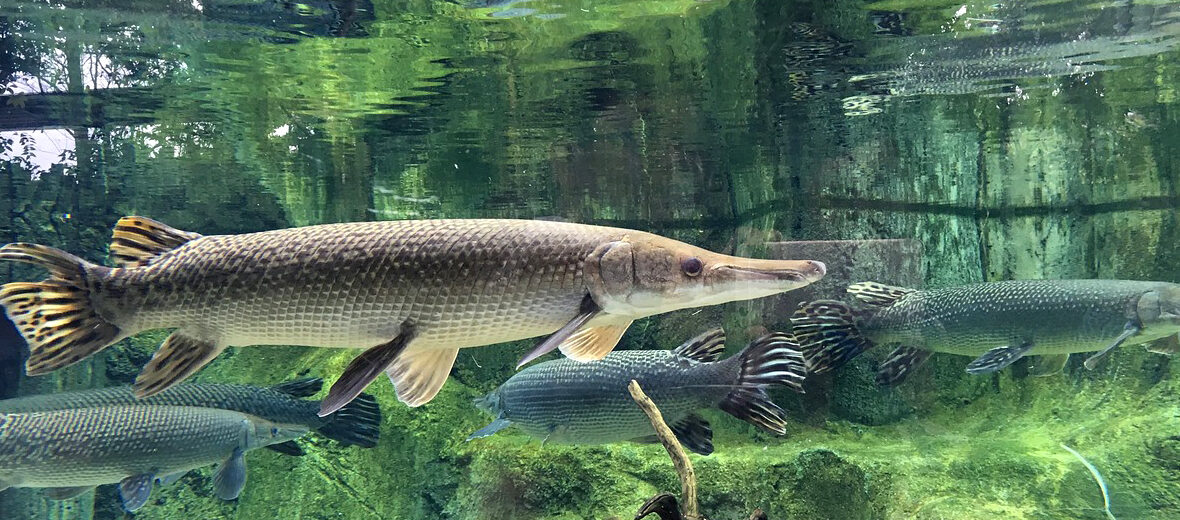
The northern pike, aka pike, is a large species of predatory fish that dwells in freshwater and sometimes even brackish (partially salty) water habitats. They can be found in Canada, United States, Europe, and Asia. With no major threats, either natural or man-made, a tendency to be invasive, and an abundant & even growing population, these fish are listed as Least Concern by the IUCN. Their population trend is listed as stable.
First the Stats…
Scientific name: Esox lucius
Weight: Up to 63 lbs.
Length: Up to 59 inches
Lifespan: Up to 25 years
Now on to the Facts!
1.) The Eurasian pike tend to grow larger than the North American specimens, and coastal northern pike are larger than inland ones.
2.) They get their common name from the resemblance to the pole-weapon known as the pike.
3.) A testament to why we use scientific names rather than common names, these fish have numerous common names such as common pike, lakes pike, great northern pike, great northern, northern, jackfish, jack, slough shark, snake, slimer, slough snake, gator, hammer handle, long head, pointy nose, luci, Lucy, luce, and more.
4.) Their preferred habitats are streams and shallow, weeded places in reservoirs and lakes, as well as in colder and clear, rocky bodies of water.
5.) They are ambush predators that will sit perfectly still for extended periods of time until a prey item happens by. Then they lunge at their prey with incredible speeds of up to 10+ mph.
But wait, there’s more on the northern pike!
6.) Cannibalism is strong with these fish, and the young spend much of their time hiding among aquatic plants and grasses to avoid becoming another pike’s dinner.
7.) Northern pike are a relatively aggressive species of fish, especially with regards to feeding behavior.
Did you know…?
In Italy, the recently identified species Esox cisalpinus (southern pike) was, for some time, thought to be merely a color variant of the northern pike, but was announced to be a species of its own in 2011.
8.) Due to cannibalism, young pike have to contend with a high mortality rate; especially when food is scarce.
9.) While typically avoiding brackish water, the individuals in the Baltic Sea spend time at the mouths of rivers.
10.) Pike are sometimes preyed on by otters.
But wait, there’s still more on the northern pike!
11.) The northern pike is primarily diurnal (active during the day).
12.) These critters typically have short digestion times and long feeding periods.
Did you know…?
There have been recorded instances of a pike attacking a dog who was wading in the water.
13.) Pike breed in the spring.
14.) A large female northern pike can lay up to 500,000 eggs.
15.) The embryos measure just .39 inch upon hatching and spend much of their time among the protective vegetation.
But wait, there’s still a little more on the northern pike!
16.) Northern pike prey primarily on fish, but will feast on frogs, tadpoles, mammals, crustaceans, and even birds. Also, as mentioned, they prey on each other.
17.) While typically considered bony, these fish are regularly consumed by humans.
18.) Pike have been consumed by humans as far back as the Roman times.
19.) This species of fish is considered invasive as they are voracious predators of anything they can get into their mouth, even if it kills them.
20.) These fish are seen as a threat to native wild stocks of salmon by some fishery managers.
Now a Short Northern Pike Video!
Be sure to share & comment below! Also, check out the Critter Science YouTube channel. Videos added regularly!
Want to suggest a critter for me to write about? Let me know here.
Some source material acquired from: Wikipedia & IUCN



